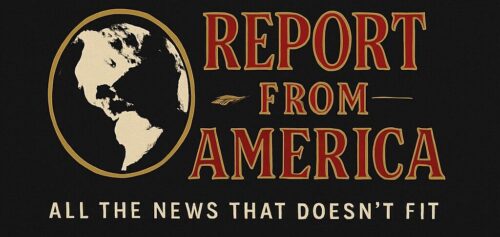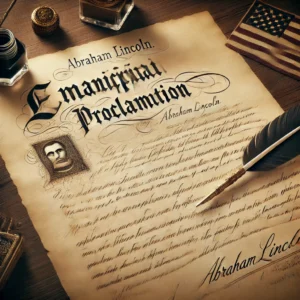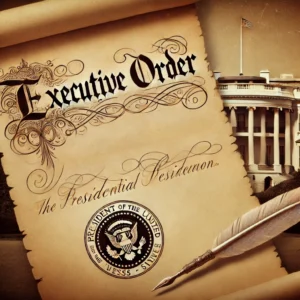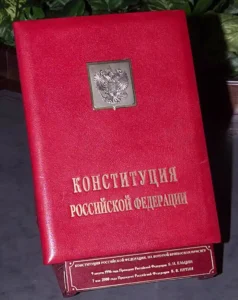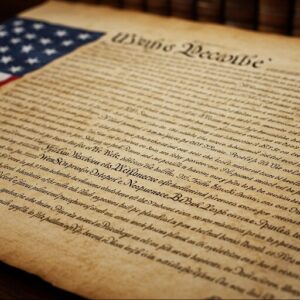As we have seen, the Constitution only gives the president a one-off authority to grant executive orders, and never actually mentions executive orders nor does it discuss the possible overlap with the legislative branch of the government. So from this gap in specificity in the Constitution, thousands of Executive Orders have been issued. Some of them were of little consequence, others might be considered frivolous, while a select few were of great and far-ranging importance. Of these, some Orders have been viewed historically as bad and of straining the Constitution, while some other orders have been viewed by history as being quite good. This page will take a look at this range.
Emancipation Proclamation
The first Executive Order that had wide-spread and long-range importance, was the Emancipation Proclamation, that took effect on January 1, 1863. The Proclamation declared all slaves who were held in rebel states were free. It did not effect slave-holding union states, nor did it apply to parts of states that were already under the control of the Union. The Proclamation drastically changed the goals of the war because the war was no longer just about States’ rights.
The Proclamation also expressly ordered that freed slaves who were fit and able were to be received into all branches of the armed forces.
Note that Lincoln expressly stated the Constitutional authority he was basing his decision to issue this order on:
Now, therefore I, Abraham Lincoln, President of the United States, by virtue of the power in me vested as Commander-in-Chief, of the Army and Navy of the United States in time of actual armed rebellion against the authority and government of the United States, and as a fit and necessary war measure for suppressing said rebellion…
Could this proclamation have been adopted by a congressional law? Probably. The rebel states were not in the Union at that time, so the remaining northern states would have had the necessary votes. However, it would not have been as expedient and dramatic. Could a future president have repealed the Proclamation. Yes, but the 13th amendment enshrined freedom for all slaves, and the 14th amendment granted citizenship to all people born in the United States–this one is worth mentioning here, because that concept will soon be subject to a fair amount of discussion.
So we have outlined the purpose and execution of the Proclamation above. There is one more thing worth noting before moving on. Historians now believe that Lincoln was well aware that this Proclamation, at this time, would give hope to all enslaved people. So in this case, we can see legislative feasibility and necessity fused with moral righteousness all in one document. As far as Executive Orders go, this might be the shining star.
One final historical note. The reader might note that Juneteenth–now a federal holiday–sometimes called Emancipation Day is on June 19th, but the Emancipation Proclamation went into effect on January 1st. The discrepancy is that Juneteenth originated in Texas, commemorating when the slaves were freed there, on June 19th, 1865. This was almost two months after the end of the Civil War. Although technically the slaves were freed by the Proclamation, it could not be enforced, in Texas, until the Union troops arrived.
Incarceration of Japanese Americans 
Let’s go to the other end of the spectrum.
In a nation gripped by fear and outrage, President Franklin Delano Roosevelt signed Executive Order 9066 – yes, as of the 1930’s Executive Orders were numbered and catalogued–which authorized the government to round-up 120,000 Japanese Americans and put them in internment camps. Two-thirds of these people were full US citizens with most of them having been born and raised in America.
Unlike Lincoln, who based his authority to write the Emancipation Proclamation on the Constitution, Roosevelt based his authority to issue this Order on an act of Congress passed during World War 1 and later amended at the start of World War II. The Act and the amended Act basically sets criminal liability standards for people who want to harm the United States of America. In both cases the Act and amended Act sets penalties for harming or conspiring to harm the United States which could be applied after conviction. So Roosevelt never mentioned a Constitutional basis for this Order and the statutes he was basing his authority on only applied penalties to people who were subjected to due process of law.
Since this action seems to clearly violate the fourth, fifth and sixth amendments to the constitution, why wasn’t it unconstitutional? Put simply, by a 6-3 majority, the Supreme Court deemed that it was constitutional because it was a “military necessity” (Korematsu vs United States). That sounds good—a military necessity—but who determines that? Does the President—one man—get to decide? Should the court defer to the President whenever he/she decides there is a military necessity? This is what a Constitutional Crisis looks like.
This one gets a footnote. Korematsu’s lower court conviction was challenged in 1983, and the case was reopened. It was found that the government withheld information proving that the Japanese Americans in California posed no threat, and the conviction was overturned. So did that fix the problem—resolve the crisis? No. That is not the way the system works. The precedent established by the Supreme Court still stands.
Generally, legal scholars consider this Supreme Court decision to have been “bad law,” and say that it could not be used as a precedent in another case.
Steven Sklansky, a law professor at Stanford, writes about the case:
“Korematsu has been, in the words of Justice Stephen Breyer, “thoroughly discredited”: by Congress, by the Executive Branch, and by the federal judiciary. Scholars and judges have long treated the decision as part of an “anti-canon”—decisions so thoroughly and unanimously repudiated that they exemplify what our law is not.” The rest of this good article can be found here.
But can we be sure? What if a president thought a matter was really important, like Roosevelt did—so important that he/she couldn’t or shouldn’t wait for Congress to act. And what if an order was signed that was clearly unconstitutional, and the matter ended up before the Supreme Court, and then let’s say there were loyalists on the Supreme Court who believed in the Constitution and the American way of life, so much so that the members of the Court thought the only path to preserving the American way of life was to go along with the President. And to top it off, this earlier Supreme Court decision is still on the books…
Could this happen? We’d like to think not but we can see the path to a Constitutional Crisis will be clear when the interplay of checks and balances breaks down.
Desegregation of the American Military

Although Lincoln, in the Emancipation Proclamation, ordered that freed slaves were to be received into the ranks of military, the US military was not desegregated until after World War II. During the War, black units, including the 322nd Fighter Group (known as the Tuskegee Airmen) and the 761st Tank Division (the Black Panthers) fought with valor, courage and distinction. This disproved previous racist notions that African American soldiers were somehow inferior to their white counterparts. Harry Truman codified this with Executive Order 9981, which ordered that there be “equality of treatment and opportunity for all persons in the armed services without regard to race, color, religion or national origin.” In World War II, African American and Japanese troops were segregated, but German and Italian American troops were not.
LGBTQ workers were barred from government jobs.
Like the first two Executive Orders highlighted—one good, one bad—these next two follow this same pattern.
Long before the term LGBTQ was coined, there was discrimination against LGBTQ workers and during the Red Scare of the 1950’s, when homosexuality was still a crime, it was thought that homosexual government workers could be vulnerable to blackmail, and were therefore a risk to national security. Dwight Eisenhower singed Executive Order 10450, barring homosexual workers from working in federal jobs. All 50 states had various laws against “sexual perversion” and this order was considered constitutional because the constitution mentions neither privacy nor sexuality, and the 10th amendment gives the states broad rights to determine laws and to govern themselves. This order technically remained in effect until it was rescinded by Barack Obama’s EO 13764.
Deploying the National Guard to Desegregate Public Schools
In 1957, nine African American children enrolled in Central High in Little Rock, Arkansas. This was three years after the Supreme Court decision in Brown v Board of Education, which declared segregation to be unconstitutional. Arkansas’ governor, Orval Faubus, who opposed integration, ordered the Arkansas National Guard to block the students from entering the school. Since post-Civil War resistance to Reconstruction, this was the first and most dramatic showdown between states’ rights and the federal government.
Affirmative Action in Government Contracting
Let’s look at one more that has an interesting history, a history which says a lot about the nature of Executive Orders. Lyndon Johnson signed Executive Order 11246 in 1965 as part of his Great Society program. Roosevelt had issued an Executive Order which was designed to end discrimination in the federal government and defense industry. But it was Johnson’s order that gave the Labor Department power to enforce anti-discrimination laws. The order has this to say about its purpose and intentions:
It is the policy of the Government of the United States to provide equal opportunity in Federal employment for all qualified persons, to prohibit discrimination in employment because of race, creed, color, or national origin, and to promote the full realization of equal employment opportunity through a positive, continuing program in each executive department and agency. The policy of equal opportunity applies to every aspect of Federal employment policy and practice.
The order goes on to discuss specifics of enforcement and policy.
This order was signed in 1965, during the Civil Rights movement, and in a then-current effort to move the country away from discrimination policies that had plagued the country since the Civil War.
So end of story? No. Executive Orders live and die by the pen. Unless they are later enshrined into laws by Congress or struck down by the Supreme Court, they can be swept away by the pen of a future president. On January 21st, 2025, the day after he was inaugurated, Johnson’s Civil Rights Order was revoked by Executive Order 11246, signed by Donald J. Trump.
__________________________________________________________________________________
History has regarded some of these Executive Orders favorably and some of them not so much. As we look forward, it is worth considering how history might favor the many Executive Order that are currently being signed.
